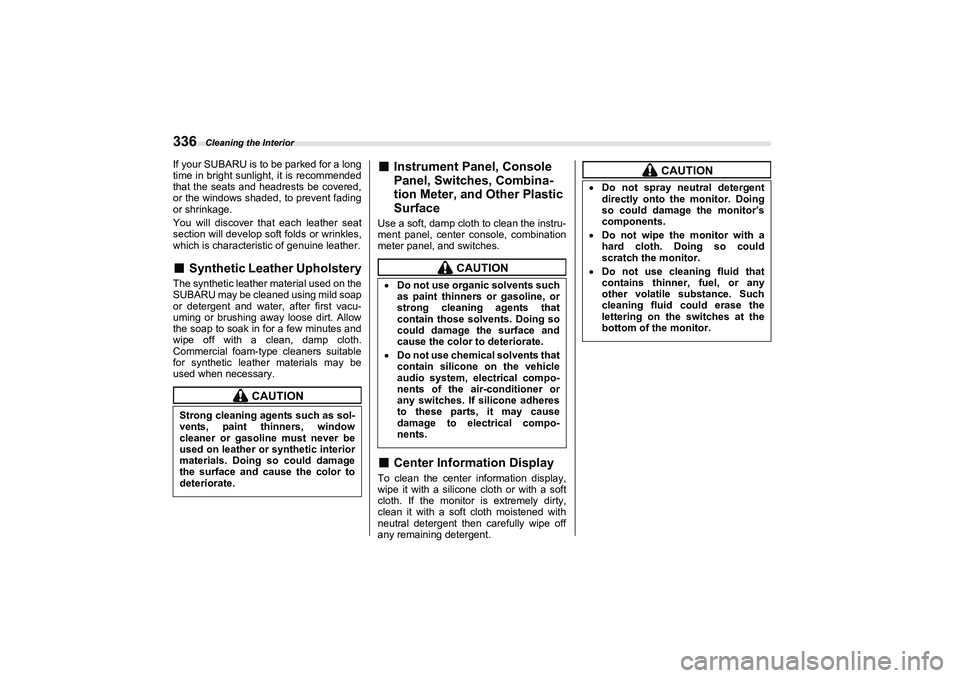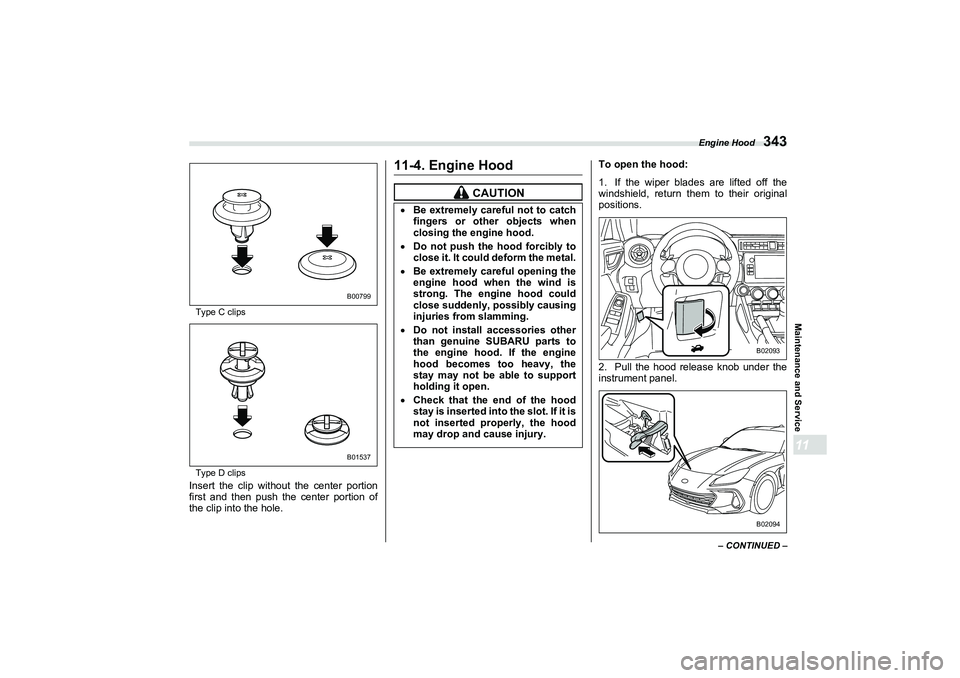Page 342 of 432

Cleaning the Interior
336If your SUBARU is to be parked for a long
time in bright sunlight, it is recommended
that the seats and headrests be covered,
or the windows shaded, to prevent fading
or shrinkage.
You will discover that each leather seat
section will develop soft folds or wrinkles,
which is characteristic of genuine leather.■
Synthetic Leather Upholstery
The synthetic leather material used on the
SUBARU may be cleaned using mild soap
or detergent and water, after first vacu-
uming or brushing away loose dirt. Allow
the soap to soak in for a few minutes and
wipe off with a clean, damp cloth.
Commercial foam-type cleaners suitable
for synthetic leather materials may be
used when necessary.
■
Instrument Panel, Console
Panel, Switches, Combina -
tion Meter, and Other Plastic
Surface
Use a soft, damp cloth to clean the instru-
ment panel, center console, combination
meter panel, and switches.■
Center Information Display
To clean the center information display,
wipe it with a silicone cloth or with a soft
cloth. If the monitor is extremely dirty,
clean it with a soft cloth moistened with
neutral detergent then carefully wipe off
any remaining detergent.
CAUTION
Strong cleaning agents such as sol-
vents, paint thinners, window
cleaner or gasoline must never be
used on leather or synthetic interior
materials. Doing so could damage
the surface and cause the color to
deteriorate.
CAUTION
Do not use organic solvents such
as paint thinners or gasoline, or
strong cleaning agents that
contain those solvents. Doing so
could damage the surface and
cause the color to deteriorate.Do not use chemical solvents that
contain silicone on the vehicle
audio system, electrical compo-
nents of the air-conditioner or
any switches. If silicone adheres
to these parts, it may cause
damage to electrical compo-
nents.
CAUTION
Do not spray neutral detergent
directly onto the monitor. Doing
so could damage the monitor’s
components.Do not wipe the monitor with a
hard cloth. Doing so could
scratch the monitor.Do not use cleaning fluid that
contains thinner, fuel, or any
other volatile substance. Such
cleaning fluid could erase the
lettering on the switches at the
bottom of the monitor.
B�5�=�B�8.�E�R�R�N 336 ページ 2021年7月5日 月曜日 午後>1時>1>1分
Page 349 of 432

Engine Hood
343
Maintenance and Service11
– CONTINUED –
Type C clips
Type D clips
Insert the clip without the center portion
first and then push the center portion of
the clip into the hole.
11-4. Engine Hood
To open the hood:
1. If the wiper blades are lifted off the
windshield, return them
to their original
positions.
2. Pull the hood release knob under the
instrument panel.
B00799B01537
CAUTION
Be extremely careful not to catch
fingers or other objects when
closing the engine hood.Do not push the hood forcibly to
close it. It could deform the metal.Be extremely careful opening the
engine hood when the wind is
strong. The engine hood could
close suddenly, possibly causing
injuries from slamming.Do not install accessories other
than genuine SUBARU parts to
the engine hood. If the engine
hood becomes too heavy, the
stay may not be able to support
holding it open.Check that the end of the hood
stay is inserted into the slot. If it is
not inserted properly, the hood
may drop and cause injury.
B02093B02094
B�5�=�B�8.�E�R�R�N 343 ページ 2021年7月5日 月曜日 午後>1時>1>1分
Page 365 of 432

Tires and Wheels
359
Maintenance and Service11
– CONTINUED –
(5.6°C) between the temperature in the
garage and the temperature outside. By
way of example, the following table shows
the required tire pressures that corre-
spond to various outside temperatures
when the temperature in the garage is
60°F (15.6°C).
Example:
Tire size: 215/40R18 85Y
Standard tire pressures:
Front: 35 psi (240 kPa, 2.4 kgf/cm
2)
Rear: 35 psi (240 kPa, 2.4 kgf/cm2)
Garage temperature: 60°F (15.6°C)
Example:
Tire size: 215/45R17 87W
Standard tire pressures:
Front: 35 psi (240 kPa, 2.4 kgf/cm2)
Rear: 35 psi (240 kPa, 2.4 kgf/cm2)
Garage temperature: 60°F (15.6°C) If the low tire pressure warning light illumi-
nates when you drive the vehicle in cold
outside air after adjusting the tire pres-
sures in a warm garage, re-adjust the tire
pressures using the method described
above. Then, increase the vehicle speed
to at least 25mph (40km/h) and check to
see that the low tire pressure warning light
goes off a few minutes later. If the low tire
pressure warning light does not go off, the
tire pressure monito
ring system may not
be functioning normally. In this event, go
to a SUBARU dealer to have the system
inspected as soon as possible.
While the vehicle is driven, friction
between tires and the road surface
causes the tires to warm up. After illumi-
nation of the low tire pressure warning
light, any increase in the tire pressures
caused by an increase in the outside air
temperature or by an increase in the
temperature in the tires can cause the low
tire pressure warning light to go off. System resetting is
necessary when the
wheels are changed (for example, a
switch to snow tires) and new TPMS
valves are installed on the newly fitted
wheels. Have this work performed by a
SUBARU dealer following wheel replace-
ment.
It may not be possible to install TPMS
valves on certain wheels that are on the
market. Therefore, if you change the
wheels (for example, a switch to snow
tires), use wheels that have the same part
number as the standard-equipment
wheels. Without four operational TPMS
valve/sensors on the wheels, the TPMS
will not fully function and the warning light
in the instrument panel will illuminate
steadily after blinking for approximately
one minute.
When a tire is replaced, adjustments are
necessary to ensure continued normal
operation of the tire pressure monitoring
system. As with wheel replacement,
therefore, you s hould have the work
performed by a SUBARU dealer.
Outside
temperature Adjusted pressure
[psi (kPa, kgf/cm
2)]
Front Rear
30°F ( −1°C) 38 (260, 2.6) 38 (260, 2.6)
10°F ( −12°C) 40 (275,
2.75) 40 (275,
2.75)
− 10°F
( − 23°C) 42 (290, 2.9) 42 (290, 2.9)
Outside
temperature Adjusted pressure
[psi (kPa, kgf/cm
2)]
Front Rear
30°F ( −1°C) 38 (260, 2.6) 38 (260, 2.6)
10°F ( −12°C) 40 (275,
2.75) 40 (275,
2.75)
− 10°F
( − 23°C) 42 (290, 2.9) 42 (290, 2.9)
B�5�=�B�8.�E�R�R�N 35�� ページ 2021年7月5日 月曜日 午後>1時>1>1分
Page 377 of 432

Fuses
371
Maintenance and Service11
– CONTINUED –
It is unnecessary to periodically check the
battery fluid level or periodically refill with
distilled water.
11-26. FusesNOTEFuse rating and using circuit are
described on the fuse box cover.
The fuses are designed to melt during an
overload to prevent damage to the wiring
harness and electrical equipment. The
fuses are located in two fuse boxes.
One is located under the instrument panel
behind the fuse box cover on the driver’s
seat side. To remove the cover, pull it out.
To lessen the risk of sparks,
remove rings, metal watchbands,
and other metal jewelry. Never
allow metal tools to contact the
positive battery terminal and
anything connected to it WHILE
you are at the same time in
contact with any other metallic
portion of the vehicle because a
short circuit will result. Keep everyone including children
away from the battery.Charge the battery in a well-venti-
lated area.Battery posts, terminals, and
related accessories contain lead
and lead compounds, chemicals
known to the State of California to
cause cancer and reproductive
harm. Batteries also contain
other chemicals known to the
State of California to cause
cancer. Wash hands after
handling.
CAUTION
Never use more than 10 amperes
when charging the battery because
it will shorten battery life.
CAUTION
Never replace a fuse with one hav-
ing a higher rating or with material
other than a fuse because serious
damage or a fire could result.
B02117
B�5�=�B�8.�E�R�R�N 3��1 ページ 2021年7月5日 月曜日 午後>1時>1>1分
Page:
< prev 1-8 9-16 17-24